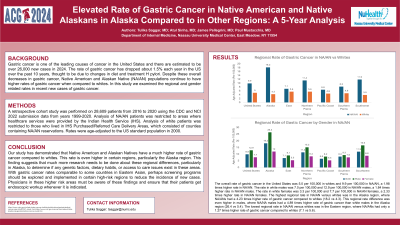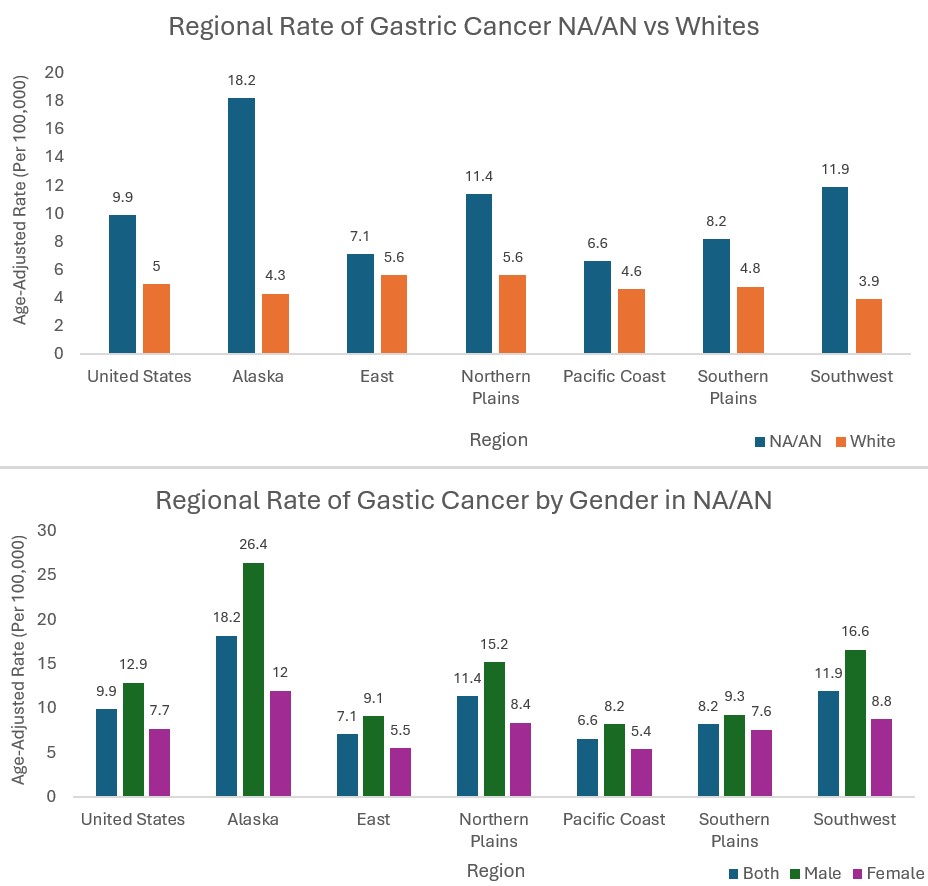Monday Poster Session
Category: Stomach
P3334 - Elevated Rate of Gastric Cancer in Native American and Native Alaskans in Alaska Compared to in Other Regions: A 5-Year Analysis
Monday, October 28, 2024
10:30 AM - 4:00 PM ET
Location: Exhibit Hall E

Has Audio

Tulika Saggar, MD
Nassau University Medical Center
East Meadow, NY
Presenting Author(s)
Tulika Saggar, MD1, Atul Sinha, MD1, James R. Pellegrini, MD2, Paul Mustacchia, MD, MBA1
1Nassau University Medical Center, East Meadow, NY; 2Nassau University Medical Center, Great River, NY
Introduction: Gastric cancer is one of the leading causes of cancer in the United States and there are estimated to be over 26,000 new cases in 2024. The rate of gastric cancer has dropped about 1.5% each year in the US over the past 10 years, thought to be due to changes in diet and treatment of H pylori. Despite these overall decreases in gastric cancer, Native American and Alaskan Native (NA/AN) populations continue to have higher rates of gastric cancer when compared to whites. In this study we examined the regional and gender related rates in recent new cases of gastric cancer.
Methods: A retrospective cohort study was performed on 28,609 patients from 2016 to 2020 using the CDC and NCI 2022 submission data from years 1999-2020. Analysis of NA/AN patients was restricted to areas where healthcare services were provided by the Indian Health Service (IHS). Analysis of white patients was restricted to those who lived in IHS Purchased/Referred Care Delivery Areas, which consisted of counties containing NA/AN reservations. Rates were age-adjusted to the US standard population in 2000.
Results: The overall rate of gastric cancer in the United States was 5.0 per 100,000 in whites and 9.9 per 100,000 in NA/AN, a 1.98 times higher rate in NA/AN. The rate in white females was 3.3 per 100,000 and 7.7 per 100,000 in NA/AN females, a 2.33 times higher rate in NA/AN females. The highest regional rate in NA/AN versus whites was in the Alaska region, where NA/ANs had a 4.23 times higher rate of gastric cancer compared to whites (18.2 vs 4.3). This regional rate difference was even higher in males, where NA/NA males had a 4.89 times higher rate of gastric cancer than white males in the Alaska region (26.4 vs 5.4).
Discussion: Our study has demonstrated that Native American and Alaskan Natives have a much higher rate of gastric cancer compared to whites. This rate is even higher in certain regions, particularly the Alaska region. This finding suggests that much more research needs to be done about these regional differences, particularly in Alaska, to determine if any genetic factors, dietary habits, or access to care issues exist in these areas. With gastric cancer rates comparable to some countries in Eastern Asian, perhaps screening programs should be explored and implemented in certain high-risk regions to reduce the incidence of new cases. Physicians in these higher risk areas must be aware of these findings and ensure that their patients get endoscopic workup whenever it is indicated.

Disclosures:
Tulika Saggar, MD1, Atul Sinha, MD1, James R. Pellegrini, MD2, Paul Mustacchia, MD, MBA1. P3334 - Elevated Rate of Gastric Cancer in Native American and Native Alaskans in Alaska Compared to in Other Regions: A 5-Year Analysis, ACG 2024 Annual Scientific Meeting Abstracts. Philadelphia, PA: American College of Gastroenterology.
1Nassau University Medical Center, East Meadow, NY; 2Nassau University Medical Center, Great River, NY
Introduction: Gastric cancer is one of the leading causes of cancer in the United States and there are estimated to be over 26,000 new cases in 2024. The rate of gastric cancer has dropped about 1.5% each year in the US over the past 10 years, thought to be due to changes in diet and treatment of H pylori. Despite these overall decreases in gastric cancer, Native American and Alaskan Native (NA/AN) populations continue to have higher rates of gastric cancer when compared to whites. In this study we examined the regional and gender related rates in recent new cases of gastric cancer.
Methods: A retrospective cohort study was performed on 28,609 patients from 2016 to 2020 using the CDC and NCI 2022 submission data from years 1999-2020. Analysis of NA/AN patients was restricted to areas where healthcare services were provided by the Indian Health Service (IHS). Analysis of white patients was restricted to those who lived in IHS Purchased/Referred Care Delivery Areas, which consisted of counties containing NA/AN reservations. Rates were age-adjusted to the US standard population in 2000.
Results: The overall rate of gastric cancer in the United States was 5.0 per 100,000 in whites and 9.9 per 100,000 in NA/AN, a 1.98 times higher rate in NA/AN. The rate in white females was 3.3 per 100,000 and 7.7 per 100,000 in NA/AN females, a 2.33 times higher rate in NA/AN females. The highest regional rate in NA/AN versus whites was in the Alaska region, where NA/ANs had a 4.23 times higher rate of gastric cancer compared to whites (18.2 vs 4.3). This regional rate difference was even higher in males, where NA/NA males had a 4.89 times higher rate of gastric cancer than white males in the Alaska region (26.4 vs 5.4).
Discussion: Our study has demonstrated that Native American and Alaskan Natives have a much higher rate of gastric cancer compared to whites. This rate is even higher in certain regions, particularly the Alaska region. This finding suggests that much more research needs to be done about these regional differences, particularly in Alaska, to determine if any genetic factors, dietary habits, or access to care issues exist in these areas. With gastric cancer rates comparable to some countries in Eastern Asian, perhaps screening programs should be explored and implemented in certain high-risk regions to reduce the incidence of new cases. Physicians in these higher risk areas must be aware of these findings and ensure that their patients get endoscopic workup whenever it is indicated.

Figure: Age-adjusted rates of gastric cancer in Native American and Alaskan Natives compared to whites by region and by gender
Disclosures:
Tulika Saggar indicated no relevant financial relationships.
Atul Sinha indicated no relevant financial relationships.
James Pellegrini indicated no relevant financial relationships.
Paul Mustacchia indicated no relevant financial relationships.
Tulika Saggar, MD1, Atul Sinha, MD1, James R. Pellegrini, MD2, Paul Mustacchia, MD, MBA1. P3334 - Elevated Rate of Gastric Cancer in Native American and Native Alaskans in Alaska Compared to in Other Regions: A 5-Year Analysis, ACG 2024 Annual Scientific Meeting Abstracts. Philadelphia, PA: American College of Gastroenterology.

